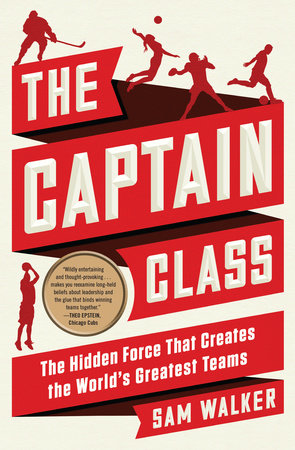In The Captain Class, Sam Walker tries to figure out what the made the greatest sports teams great. The subtitle of the book is “the hidden force that creates the world’s greatest teams,” but attentive readers will note that the “the hidden force” is in the first part of the title. Walker spends the first section of the book defining what constitutes a great team. He does an impressive search for the most dominant teams and comes up with 12. Some of them are the usual suspects such as the Boston Celtics of the 1960s and the Tim Duncan-era Spurs, but he also goes to the All-Blacks rugby team of New Zealand and a Cuban volleyball team.
This identification part of the book was rather dull and I am afraid that I usually have made up my mind about a book about halfway through. However, The Captain Class rallies nicely in the second half as Walker spotlights the one thing that these teams had in common: each had a captain who was willing to do the dirty work and not get all of the accolades. For example, Pele was the most famous Brazilian soccer player of his era (and maybe any era), but he was not the captain of the World Cup-winning teams. The captain was a midfielder named Carlos Alberto Torres who organized the team. Stars are rarely captains. Duncan and Yogi Berra were counter-examples of players who were Hall of Famers, but most of the captains detailed in the book were not famous and many actually shunned the limelight.
As the book moves away from sports, I thought it became more interesting. Walker identifies seven key leadership aspects of captains, and delves into psychological and sociological studies to fully illustrate each point. He uses some of the captains to introduce the concepts. Duncan is an example of a player who used non-verbal communication to bring his teammates together. One of the most intriguing examples was the women’s Cuban volleyball team which taunted its opponent in the Olympics to push the boundaries of the rules. The taunts threw the team’s opponents off their game and allowed the Cubans to take home the gold medal. Walker shows how captains are able to regulate their emotions and can sometimes even question coaches and management.
The narrative starts to break down when Walker tries to show how players like Michael Jordan were not of the captain class. Tier 1 teams had to win four championships in five seasons (which the Spurs never did), but Jordan does not fit the mold. He seemed more interested in his own stats and was not always able to regulate his emotions. The team won six championships in eight seasons and was the dominant force in the NBA in the 1990s. Perhaps Walker could have examined a player like Scottie Pippen, who did a lot of defensive dirty work for the Bulls. He also bemoans the fact that some teams do not name captains any more. To me, being named captain is something that management bestows on a player and is not more than a tag. Players who exhibit these traits would likely not care that much about getting approval.
As I read, I wondered how LeBron James would figure into the captain class. He would likely be eliminated from consideration because he has not won enough championships. James also does not push the rules and is sometimes willing to blame his teammates for his team’s failures. These are not captain characteristics. He certainly makes his team better and has improved his game throughout the years. While a championship does not seem to be in the cards in 2016-17, the fact that James has taken his team to seven straight NBA Finals is at least as impressive as what Tim Duncan did. By the way, I looked up the Cavalier roster: James, Kevin Love, and Kyrie Irving are all named captains.
Captain inflation has also hit the Golden State Warriors, who have five captains. For some reason, none of them are named Zaza Pachulia, but the other four starters plus Andre Iguodala all have the “C” on their uniforms. Should Walker decide to update his book in a few years, Draymond Green would certainly fit the narrative. He was overlooked in the draft and is not a big scorer. Green is willing to push the rules and seems to be the player who has pushed the Warriors to their current three-year winning spree. If the Warriors ever want to fit their team to The Captain Class, they’d strip the other four players of their captaincies and let Green be their leadership symbol.
Grab a copy here:
[protected-iframe id=”a4ac208418253baefde9e7fbceb4513f-114320562-9927038″ info=”//ws-na.amazon-adsystem.com/widgets/q?ServiceVersion=20070822&OneJS=1&Operation=GetAdHtml&MarketPlace=US&source=ss&ref=as_ss_li_til&ad_type=product_link&tracking_id=thehooman01-20&marketplace=amazon®ion=US&placement=0812997190&asins=0812997190&linkId=d6b753a1446f68f31c56438bb0078ad6&show_border=true&link_opens_in_new_window=true” width=”300″ height=”150″ frameborder=”0″ style=”width: 120px; height: 240px;” scrolling=”no”]Add The Sports Daily to your Google News Feed!
